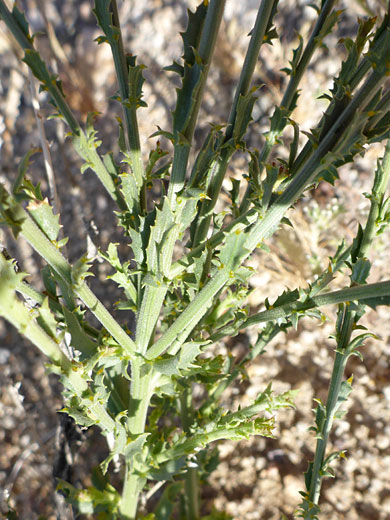Common name:
Cooper's dogweed
Family:
Scientific name:
Adenophyllum cooperi
Main flower color:
Range:
The Mojave Desert (AZ, CA, NV, UT)
Height:
Up to 20 inches
Habitat:
Desert washes, alluvial fans, rocky hillsides, from 2,000 to 6,000 feet
Leaves:
Alternate, ovate to oblanceolate, up to 1 inch long, with toothed edges
Season:
April to June
The main, springtime flowering period of adenophyllum cooperi is often followed by a second bloom in the fall. Stems and leaves are grey-green in color, and covered by short, fine, spreading hairs. Leaves have one or two pairs of yellow oil glands at the base and another pair at the tip. Leaf margins are lined with large, irregular teeth. Leaves may have a pair of lobes at the base, but are usually unlobed.
Flowerheads form singly at the top of the stems; they are subtended by between 12 and 22 linear bracts, light green in color, ascending, and tapering to a slender tip. The green phyllaries are broader, lanceolate in shape, reddish towards the tip. Oil glands are also present on the bracts and phyllaries. Ray florets may be absent, or number between 7 and 14, colored orange yellow, becoming red when mature. The 50 to 80 disc florets are yellow to reddish-orange, and may be pistillate or staminate.
Flowerheads form singly at the top of the stems; they are subtended by between 12 and 22 linear bracts, light green in color, ascending, and tapering to a slender tip. The green phyllaries are broader, lanceolate in shape, reddish towards the tip. Oil glands are also present on the bracts and phyllaries. Ray florets may be absent, or number between 7 and 14, colored orange yellow, becoming red when mature. The 50 to 80 disc florets are yellow to reddish-orange, and may be pistillate or staminate.
All Contents © Copyright The American Southwest | Comments and Questions | Contribute | Site Map



